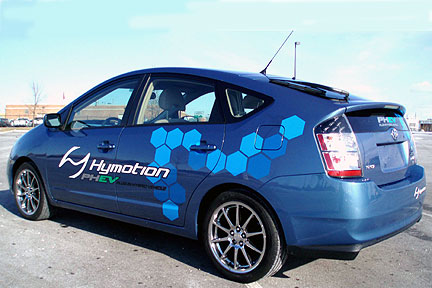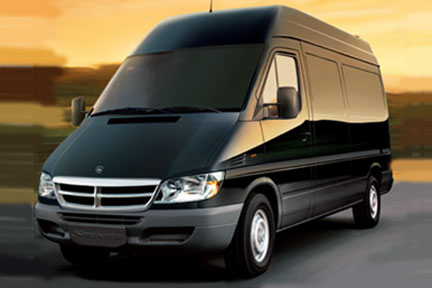Hybrid cars and SUVs are selling well, with ever more coming to market. Hybrid school buses are already carrying kids. Hybrid shuttle buses, refuse and utility trucks are ready for production. FedEx, UPS and Puralator have hybrid package-delivery trucks in their fleets. Some 500 hybrid electric transit buses are already in service around the country.

|
| Prius with HyMotion Plug-in conversion. |
Next step are plug-in hybrid electric vehicles, also called grid connected hybrids. The PHEV's batteries are charged from the electric grid using a common household 110-volt outlet while parked, as well as by the internal combustion engine while driving. This reduces the amount of time the internal combustion engine has to operate, and thus reduces fuel consumption and emissions. PHEVs can be plugged into the electric grid at night to recharge the batteries when electric rates are usually lower. PHEVs have larger capacity batteries so they have longer "electric only" ranges.
General Motors plans to offer a Saturn Vue Green Line plug-in hybrid that could double the fuel economy of any current SUV and offer electric-only propulsion for more than 10 miles. Toyota has also indicated that is working on a PHEV, probably for the hot selling Prius.
CalCars, a PHEV advocacy group, working with EnergyCS, has developed a conversion kit for retrofitting for Prius. EnergyCS's EDrive system has demonstrated over 100 MPG by adding grid recharging ability. A nightly re-charge of about $1 worth of electricity halves the Prius' gasoline consumption for over 50 miles the following day. Then it performs like a standard Prius until plugged in again.
HyMotion in Canada has developed upgrade kits for the Toyota Prius, Ford Escape and Mercury Mariner Hybrids. Others are under development for the Lexus RX400h, Toyota Highlander Hybrid and Toyota Camry Hybrid. The Hymotion PHEV kits use a supplementary lithium-ion battery pack. In contrast, the EDrive conversion replaces, not augments, the regular Prius battery pack with a Li-ion battery for storing the additional electrical energy.

|
| Dodge Sprinter PHEV. |
As part of DaimlerChrysler's worldwide testing of PHEV technology, it is placing 40 Dodge Sprinter Plug-in PHEVs in operation California, Kansas City and New York. The Dodge plug-in hybrid Sprinter has a much larger battery which gives the vehicle the ability to drive up to 20 miles on electric-only power. Two engines can be mated to the PHEV system, a five cylinder diesel and a V6 gasoline.
Some of 20 hybrid electric school buses that are going into service as part of the Hybrid Electric School Bus project have plug-in capability. These buses were developed by IC Corporation and Enova Systems. They will be in service in 11 states from Florida to Washington with locations chosen to evaluate their performance and feasibility under a variety of conditions. A 30- to 50- percent savings is anticipated with the hybrid only version. This increases to as much as 70- to 100- percent with PHEV capability when the bus can run up to 44 miles on electric power alone.
When it comes to grid connected capability for medium- and heavy-duty trucks, Odyne Corp. in New York is leading the way. It has, or will be applying, its plug-in technology to refuse and recycling pickup trucks, transit buses, and delivery trucks. It calls it Hybrid Electric Propulsion System 'fuel agnostic' because they will work with any fuel - gasoline, diesel, biodiesel, ethanol, propane, and natural gas.
So why are PHEVs not already available? Like any electric vehicle, the limiting items are battery technology and cost. The additional all-electric range requires larger and much more expensive battery systems to store the additional electric energy. The grid connected capability with the EDrive or HyMotion systems adds roughly $10,000 to the price of a Prius.
PHEVs can replace mobile emission sources, that is gasoline and diesel engines, with stationary central power plant sources that are already much cleaner and easier to control. PHEVs move stationary emissions from daylight hours to night time hours, thus reducing the creation of ozone and smog.
However, the recent report by the American Council for an Energy-Efficient America cautions that the environmental benefits of PHEVs can vary significantly by region. In California, where most electricity on the grid is generated by low-pollution facilities, a PHEV might cut emissions of carbon dioxide by one-third compared to a regular hybrid. In the Midwest though, where coal-fired power plants supply the electricity, there would little reduction in CO2 emissions, but nitrous-oxide emissions would fall slightly and sulfur-dioxide emissions would quadruple.




